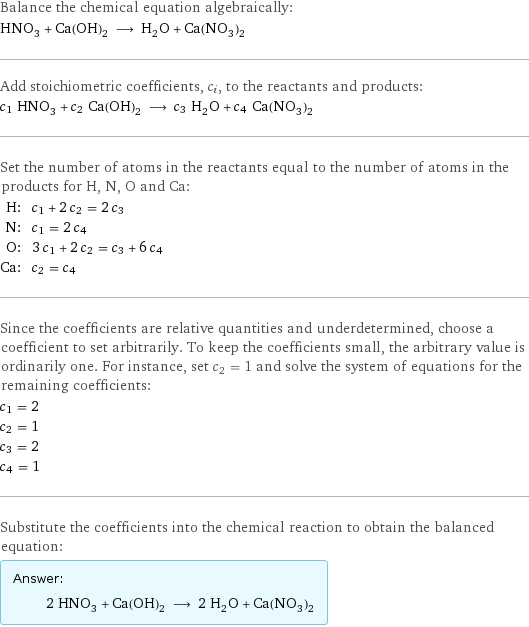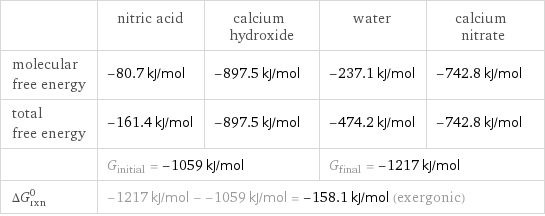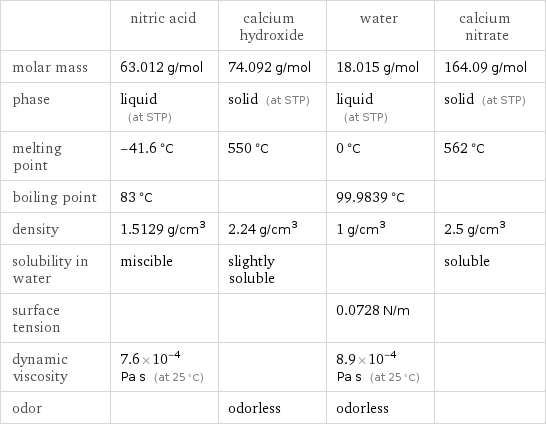Input interpretation

HNO_3 (nitric acid) + Ca(OH)_2 (calcium hydroxide) ⟶ H_2O (water) + Ca(NO_3)_2 (calcium nitrate)
Balanced equation

Balance the chemical equation algebraically: HNO_3 + Ca(OH)_2 ⟶ H_2O + Ca(NO_3)_2 Add stoichiometric coefficients, c_i, to the reactants and products: c_1 HNO_3 + c_2 Ca(OH)_2 ⟶ c_3 H_2O + c_4 Ca(NO_3)_2 Set the number of atoms in the reactants equal to the number of atoms in the products for H, N, O and Ca: H: | c_1 + 2 c_2 = 2 c_3 N: | c_1 = 2 c_4 O: | 3 c_1 + 2 c_2 = c_3 + 6 c_4 Ca: | c_2 = c_4 Since the coefficients are relative quantities and underdetermined, choose a coefficient to set arbitrarily. To keep the coefficients small, the arbitrary value is ordinarily one. For instance, set c_2 = 1 and solve the system of equations for the remaining coefficients: c_1 = 2 c_2 = 1 c_3 = 2 c_4 = 1 Substitute the coefficients into the chemical reaction to obtain the balanced equation: Answer: | | 2 HNO_3 + Ca(OH)_2 ⟶ 2 H_2O + Ca(NO_3)_2
Structures

+ ⟶ +
Names

nitric acid + calcium hydroxide ⟶ water + calcium nitrate
Reaction thermodynamics
Gibbs free energy

| nitric acid | calcium hydroxide | water | calcium nitrate molecular free energy | -80.7 kJ/mol | -897.5 kJ/mol | -237.1 kJ/mol | -742.8 kJ/mol total free energy | -161.4 kJ/mol | -897.5 kJ/mol | -474.2 kJ/mol | -742.8 kJ/mol | G_initial = -1059 kJ/mol | | G_final = -1217 kJ/mol | ΔG_rxn^0 | -1217 kJ/mol - -1059 kJ/mol = -158.1 kJ/mol (exergonic) | | |
Equilibrium constant
![Construct the equilibrium constant, K, expression for: HNO_3 + Ca(OH)_2 ⟶ H_2O + Ca(NO_3)_2 Plan: • Balance the chemical equation. • Determine the stoichiometric numbers. • Assemble the activity expression for each chemical species. • Use the activity expressions to build the equilibrium constant expression. Write the balanced chemical equation: 2 HNO_3 + Ca(OH)_2 ⟶ 2 H_2O + Ca(NO_3)_2 Assign stoichiometric numbers, ν_i, using the stoichiometric coefficients, c_i, from the balanced chemical equation in the following manner: ν_i = -c_i for reactants and ν_i = c_i for products: chemical species | c_i | ν_i HNO_3 | 2 | -2 Ca(OH)_2 | 1 | -1 H_2O | 2 | 2 Ca(NO_3)_2 | 1 | 1 Assemble the activity expressions accounting for the state of matter and ν_i: chemical species | c_i | ν_i | activity expression HNO_3 | 2 | -2 | ([HNO3])^(-2) Ca(OH)_2 | 1 | -1 | ([Ca(OH)2])^(-1) H_2O | 2 | 2 | ([H2O])^2 Ca(NO_3)_2 | 1 | 1 | [Ca(NO3)2] The equilibrium constant symbol in the concentration basis is: K_c Mulitply the activity expressions to arrive at the K_c expression: Answer: | | K_c = ([HNO3])^(-2) ([Ca(OH)2])^(-1) ([H2O])^2 [Ca(NO3)2] = (([H2O])^2 [Ca(NO3)2])/(([HNO3])^2 [Ca(OH)2])](../image_source/8903eba169e4062e400e1913c295e2f6.png)
Construct the equilibrium constant, K, expression for: HNO_3 + Ca(OH)_2 ⟶ H_2O + Ca(NO_3)_2 Plan: • Balance the chemical equation. • Determine the stoichiometric numbers. • Assemble the activity expression for each chemical species. • Use the activity expressions to build the equilibrium constant expression. Write the balanced chemical equation: 2 HNO_3 + Ca(OH)_2 ⟶ 2 H_2O + Ca(NO_3)_2 Assign stoichiometric numbers, ν_i, using the stoichiometric coefficients, c_i, from the balanced chemical equation in the following manner: ν_i = -c_i for reactants and ν_i = c_i for products: chemical species | c_i | ν_i HNO_3 | 2 | -2 Ca(OH)_2 | 1 | -1 H_2O | 2 | 2 Ca(NO_3)_2 | 1 | 1 Assemble the activity expressions accounting for the state of matter and ν_i: chemical species | c_i | ν_i | activity expression HNO_3 | 2 | -2 | ([HNO3])^(-2) Ca(OH)_2 | 1 | -1 | ([Ca(OH)2])^(-1) H_2O | 2 | 2 | ([H2O])^2 Ca(NO_3)_2 | 1 | 1 | [Ca(NO3)2] The equilibrium constant symbol in the concentration basis is: K_c Mulitply the activity expressions to arrive at the K_c expression: Answer: | | K_c = ([HNO3])^(-2) ([Ca(OH)2])^(-1) ([H2O])^2 [Ca(NO3)2] = (([H2O])^2 [Ca(NO3)2])/(([HNO3])^2 [Ca(OH)2])
Rate of reaction
![Construct the rate of reaction expression for: HNO_3 + Ca(OH)_2 ⟶ H_2O + Ca(NO_3)_2 Plan: • Balance the chemical equation. • Determine the stoichiometric numbers. • Assemble the rate term for each chemical species. • Write the rate of reaction expression. Write the balanced chemical equation: 2 HNO_3 + Ca(OH)_2 ⟶ 2 H_2O + Ca(NO_3)_2 Assign stoichiometric numbers, ν_i, using the stoichiometric coefficients, c_i, from the balanced chemical equation in the following manner: ν_i = -c_i for reactants and ν_i = c_i for products: chemical species | c_i | ν_i HNO_3 | 2 | -2 Ca(OH)_2 | 1 | -1 H_2O | 2 | 2 Ca(NO_3)_2 | 1 | 1 The rate term for each chemical species, B_i, is 1/ν_i(Δ[B_i])/(Δt) where [B_i] is the amount concentration and t is time: chemical species | c_i | ν_i | rate term HNO_3 | 2 | -2 | -1/2 (Δ[HNO3])/(Δt) Ca(OH)_2 | 1 | -1 | -(Δ[Ca(OH)2])/(Δt) H_2O | 2 | 2 | 1/2 (Δ[H2O])/(Δt) Ca(NO_3)_2 | 1 | 1 | (Δ[Ca(NO3)2])/(Δt) (for infinitesimal rate of change, replace Δ with d) Set the rate terms equal to each other to arrive at the rate expression: Answer: | | rate = -1/2 (Δ[HNO3])/(Δt) = -(Δ[Ca(OH)2])/(Δt) = 1/2 (Δ[H2O])/(Δt) = (Δ[Ca(NO3)2])/(Δt) (assuming constant volume and no accumulation of intermediates or side products)](../image_source/ed5f2fd0d0b2417ca033c67a9c672b8d.png)
Construct the rate of reaction expression for: HNO_3 + Ca(OH)_2 ⟶ H_2O + Ca(NO_3)_2 Plan: • Balance the chemical equation. • Determine the stoichiometric numbers. • Assemble the rate term for each chemical species. • Write the rate of reaction expression. Write the balanced chemical equation: 2 HNO_3 + Ca(OH)_2 ⟶ 2 H_2O + Ca(NO_3)_2 Assign stoichiometric numbers, ν_i, using the stoichiometric coefficients, c_i, from the balanced chemical equation in the following manner: ν_i = -c_i for reactants and ν_i = c_i for products: chemical species | c_i | ν_i HNO_3 | 2 | -2 Ca(OH)_2 | 1 | -1 H_2O | 2 | 2 Ca(NO_3)_2 | 1 | 1 The rate term for each chemical species, B_i, is 1/ν_i(Δ[B_i])/(Δt) where [B_i] is the amount concentration and t is time: chemical species | c_i | ν_i | rate term HNO_3 | 2 | -2 | -1/2 (Δ[HNO3])/(Δt) Ca(OH)_2 | 1 | -1 | -(Δ[Ca(OH)2])/(Δt) H_2O | 2 | 2 | 1/2 (Δ[H2O])/(Δt) Ca(NO_3)_2 | 1 | 1 | (Δ[Ca(NO3)2])/(Δt) (for infinitesimal rate of change, replace Δ with d) Set the rate terms equal to each other to arrive at the rate expression: Answer: | | rate = -1/2 (Δ[HNO3])/(Δt) = -(Δ[Ca(OH)2])/(Δt) = 1/2 (Δ[H2O])/(Δt) = (Δ[Ca(NO3)2])/(Δt) (assuming constant volume and no accumulation of intermediates or side products)
Chemical names and formulas

| nitric acid | calcium hydroxide | water | calcium nitrate formula | HNO_3 | Ca(OH)_2 | H_2O | Ca(NO_3)_2 Hill formula | HNO_3 | CaH_2O_2 | H_2O | CaN_2O_6 name | nitric acid | calcium hydroxide | water | calcium nitrate IUPAC name | nitric acid | calcium dihydroxide | water | calcium dinitrate
Substance properties

| nitric acid | calcium hydroxide | water | calcium nitrate molar mass | 63.012 g/mol | 74.092 g/mol | 18.015 g/mol | 164.09 g/mol phase | liquid (at STP) | solid (at STP) | liquid (at STP) | solid (at STP) melting point | -41.6 °C | 550 °C | 0 °C | 562 °C boiling point | 83 °C | | 99.9839 °C | density | 1.5129 g/cm^3 | 2.24 g/cm^3 | 1 g/cm^3 | 2.5 g/cm^3 solubility in water | miscible | slightly soluble | | soluble surface tension | | | 0.0728 N/m | dynamic viscosity | 7.6×10^-4 Pa s (at 25 °C) | | 8.9×10^-4 Pa s (at 25 °C) | odor | | odorless | odorless |
Units
